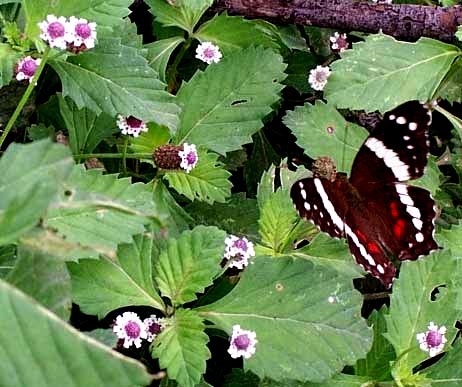Excerpts from Jim Conrad's
Naturalist Newsletter
from the May 5, 2007 Newsletter issued from Sierra Gorda Biosphere Reserve, QUERÉTARO, MÉXICO
A BANDED PEACOCK, AND HOW I IDENTIFIED IT
On the torrid afternoon when I took the above frogfruit picture, not only was the frogfruit tangle teeming with tiny toads but also a certain species of familiar-looking butterfly was visiting frogfruit flowers en masse, as shown below:

That butterfly is the Banded Peacock, ANARTIA FATIMA, distributed from southern Texas to Panama. It's found very commonly in disturbed habitats, at forest edges and along the banks of natural watercourses -- "riparian" habitats like where I saw it. Even though the adults live only for two to four weeks, the species is so prolific that it's seen throughout the year.
The reason I said the Banded Peacock was familiar looking is that the species belongs to the same butterfly family and subfamily as the Red Admiral, Painted Lady, Common Buckeye and several other similar-looking butterflies often seen in my US haunts.
Since no "Fieldguide to Mexican Butterflies" exists and I don't claim to be a lepidopterist, how did I identify this Banded Peacock?
Because it was so similar to those North American species mentioned above I went to the {now defunct} Mariposas Mexicanas website (the word "mariposa" is Spanish for "butterfly") clicked on the Subfamily Nymphalinae of the family Nymphaldae, to which all the above-mentioned species belong, then simply compared pictures until I had a decent match. That website {was} the closest thing we have to a "Fieldguide to Mexican Butterflies."
Once I had a name I confirmed the identification by looking it up on the newly reconstituted "Butterflies and Moths of North America" website at ButterfliesAndMoths.Org. That site provides wonderful distribution maps, and you can even call up maps for Mexico. However, it seems to feature only those Mexican species whose distributions extend into the US -- such as our Banded Peacock.
What a very powerful tool for naturalists the Internet has become, especially for those of us in parts of the world where printed fieldguides are nonexistent.